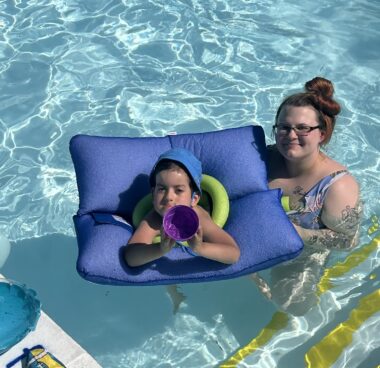Our new pool float is designed for my son’s limited mobility
In this heat wave, it's good to have a device that works for his age and size
Written by |

Now that summer is here in full force, I’ve been finding things to do with my 6-year-old son, Cayden, and his baby brother, Kyree. We’re now battling a terrible heat wave here in Pennsylvania, which makes going outside miserable. We’ve been experiencing temperatures in the 90s for days on end, with no rain in sight.
Thankfully, we’ve been able to take advantage of our community pool to cool off. Both boys absolutely love the water, and I’m grateful for that because not all kids do. This year, however, we had to find a way to make it safe for Cayden to enter the pool.
Because Cayden has infantile-onset Pompe disease, he has limited mobility. Even though he moves more easily in the pool, he just doesn’t have enough muscular strength to stand up in or out of it. To enjoy the pool safely, he needs to be in a flotation device. Our problem is that most pool floats are for babies or toddlers; there aren’t many options for children his age or size.
Finding the right flotation device
For years, we kept using a baby float for Cayden. Last summer, however, we had a scary incident when he tipped over in the float and was fully submerged. Of course, he’s never in the pool alone and has eyes on him at all times, so we got him out of the water right away. Still, he was shaken up and refused to go back into the pool, aside from dangling his feet in the water as he sat on the edge of it.
This year my mother and I made it a mission to find some kind of device that would suit him better. It was quite the search. We looked high and low online for flotation devices that target people with disabilities who don’t have much strength. Eventually, we came across one that seemed perfect.
The product we found is made in Australia. It’s actually advertised for children with cerebral palsy, which is another condition that causes low muscle tone. The only problem we had was with the price. After the cost and shipping fees to the United States, it came out to be a little over $300.

Cayden Camacho enjoys the pool in his new float alongside his mom, Keara Engle. (Courtesy of Keara Engle)
That didn’t stop us from making the purchase. My mother and I, along with a few others in the family, all pitched in money to cover the cost. Surprisingly, shipping didn’t take all that long. We received it in a little over a week, just in time to use it during this awful heat wave.
We had to adjust it for Cayden, and we added a pool noodle around his body to make it more comfortable for him. After that, Cayden was in the pool enjoying himself. He kept telling us, “I’m not scared. I feel safe!” That made me so happy because I remember his anxiety about the pool after last year’s incident.
I’m excited to spend more days at the pool this summer, but I’m even more excited that Cayden can join in on the fun once again. I appreciate everyone who came together to pitch in money to make this happen, and I’m glad he can enjoy this new device for years to come.
Note: Pompe Disease News is strictly a news and information website about the disease. It does not provide medical advice, diagnosis, or treatment. This content is not intended to be a substitute for professional medical advice, diagnosis, or treatment. Always seek the advice of your physician or other qualified health provider with any questions you may have regarding a medical condition. Never disregard professional medical advice or delay in seeking it because of something you have read on this website. The opinions expressed in this column are not those of Pompe Disease News or its parent company, Bionews, and are intended to spark discussion about issues pertaining to Pompe disease.







Leave a comment
Fill in the required fields to post. Your email address will not be published.